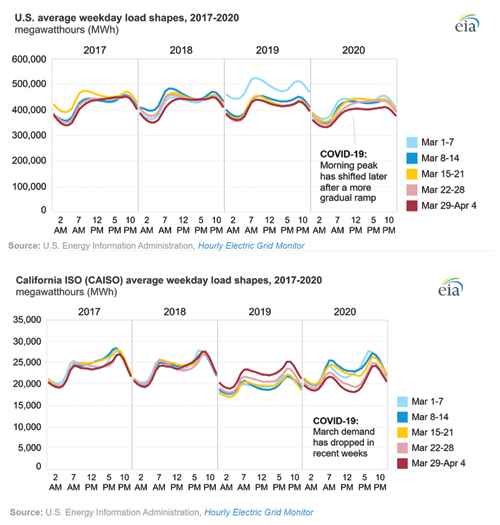As the electric power industry adjusts to the impact of the COVID-19 pandemic, we are pleased to feature the following article by Farnoosh Rahmatian, past chair, IEEE Power & Energy Society Technical Council, President, NuGrid Power Corp.
As readers may know, extreme weather is the leading cause of power outages in the United States and, likely, across much of the developed world. Thus, storm preparedness and resiliency are central to what well-managed power utilities do every day.
Some major utilities in developed countries include pandemic preparedness in their scenario planning. That appears to depend on having robust resources dedicated to scenario planning and how those resources are allocated. For perhaps most utilities around the world, however, pandemic preparedness simply hasn’t been a concern – until now.
Today, utilities around the world must deal with a pandemic as they brace for storms. For example, utilities in the southeastern U.S. are entering their annual hurricane
season as utilities in southeast Asia face monsoons. In both cases, on opposite sides of the world, these utilities must adapt their operations to meet the demanding new challenges of a coronavirus pandemic as they prepare for the year’s most impactful storms and the service restoration efforts that must follow.
Just as the on-the-ground impacts of an approaching, extreme weather event cannot be fully and accurately predicted in a storm preparation scenario, the dynamics and impacts of the current pandemic are not yet fully understood. Yet, the broad parameters of both challenges can be anticipated, and well-defined actions can be taken to reduce their impacts. Meeting either challenge or both simultaneously, remains a work-in-progress. That underscores the value of sharing our experiences, challenges and responses in this unique situation.
As a recent white paper compiled and written by the IEEE Power & Energy Society (PES), “Sharing Knowledge on Electrical Energy Industry’s First Response to COVID-19” makes clear, the pandemic has affected utilities around the world in diverse ways, and they have devised myriad responses. This article documents the global diversity of impacts and responses to provide a resource for an industry still adapting to evolving conditions. To accomplish this task, we leveraged the IEEE PES’ 39,000+ members in 230 chapters on every continent (except Antarctica) to create a valuable resource for utilities seeking innovative solutions.
One of the white paper’s key findings is that utilities view the pandemic as having mid- and long-term impacts on storm preparedness and resiliency. (To view the white paper, visit https://resourcecenter.ieee-pes.org.)
Well-established solutions such as substation hardening, increased visibility via additional sensors, improved data analytics, implementing microgrids to protect critical facilities and other measures may already be in place, underway or in the planning phase. Yet the pandemic may impact the continuity of these ongoing efforts as utilities experience challenges to workforce health and stability, declines in revenue as commercial/industrial (C&I) activity slows, new technical challenges as loads and peaks shift to residential customers and new budgetary priorities arise.
The good news is that power utilities the world over seem to be coping reasonably well at this point, adapting to diverse, disruptive circumstances. Utility leaders and staff have on-the-fly devised ways to protect themselves while safely keeping the power on for our increasingly digital, global society. The past decade of work on grid modernization and storm preparedness has paid dividends in the pandemic. Lessons learned from superstorms of the recent past have led to increased grid hardening. The advent of intelligent electronic devices (IEDs) and data-based applications has improved visibility and control. Automation has enabled some self-healing. Data analytics are moving the industry from a reactive response to an informed, proactive approach. Increasingly, microgrids are being considered to ensure continuity for critical facilities and roles such as hospitals, public safety, disadvantaged neighborhoods, utility control centers and elsewhere.
If we sound a positive note by declaring the glass half-full, however, it is our responsibility to acknowledge that the glass is half-empty as well. So, let’s take a look at how the pandemic has affected utilities generally and how that impacts storm preparedness and resiliency specifically.
An overview
A survey that sampled utilities around the world in March-April found that the pandemic has had technical impacts in terms of forcing utilities to manage shifts in load and peak load as human activities have shifted. This makes sense. While a hurricane can flood a substation or a cyberattack can paralyze an operations center, a virus that primarily targets the human respiratory system will not affect the grid’s hardware and software or the actual generation, transmission and distribution of power. A pandemic does not cripple critical infrastructure directly, but it impacts the people who use it, the people who run it and how they run it.
Our survey documented the pandemic’s wide-ranging impacts on people and how they address control center, field and critical business operations. That, in turn, affects how utility staff performs scenario planning that covers storm preparedness and resiliency efforts. Generally, a pandemic can lead to a diversion of human and financial resources that may reduce the resources devoted to storm preparedness and restoration planning. Yet a pandemic also requires renewed attention to these areas as, for example, vegetation management contractors see high demand, supply chains may be disrupted, mutual aid becomes more challenging and workarounds need defining.
External to power utility operations, the pandemic has in many cases forced a slowdown in C&I activity and an increase in people working from home and/or sheltering in place. Resulting, documented shifts in load profiles and peaks may in places produce operational challenges that generally require adjustments but so far have not threatened power network integrity.
We expect that in the lag between our survey and the publication of this article we may see an evolution in utility impacts and responses. So, the following insights represent the power industry’s first response to the coronavirus pandemic.
Control center impacts, responses
If the pandemic itself largely impacts people, then it follows that it impacts utility staff and how they safely accomplish their roles in all aspects of utility operations. Our survey found that this holds true for staff that runs vital control center operations. Typically, power utility control centers have more than a dozen people in a single room monitoring and controlling the grid at two or more redundant facilities. If one goes down, the other takes over. These operators are responsible for situational awareness of the grid’s status and behavior and for taking appropriate action when necessary. Typically, these crews work around the clock in three eight-hour shifts.
A pandemic poses a threat to the health of these highly skilled crews. In a pandemic, staff may have to adopt strict guidelines to ensure their own health and, thus availability for duty. In extreme cases, such as a virus “hot spot,” the staff may have to be physically sequestered, which has ramifications. Sequestration would require a utility to provide staff with personal protection equipment (PPE), virus testing, symptom screening, overnight accommodations, meals and news/entertainment. The providers of those services might themselves require sequestration. There’s a time limit to sequestration before workers’ effectiveness at their job begins to degrade and isolation from family takes its toll. Options to meet these challenges may include reducing staff for each shift, creating two 12-hour shifts and maintaining a reserve staff to take over for a crew stricken by illness or fatigue. Control center staffers may have to bring their own keyboards, monitors, headsets to each shift to limit the potential for contact with potentially contaminated surfaces.
Several utilities in the most hard-hit regions in the world have taken the extreme step of sequestration. The New York Power Authority, Southern California Edison and State Grid Corporation of China are examples of utilities that are undertaking sequestration. Meanwhile, even in Europe’s hardest-hit countries such as Italy and Spain, utilities have largely abstained from sequestration and instead required control center workers to follow strict guidelines for maintaining isolation and their health.
Field operations and mutual aid
Safely staffing field operations typically requires multiple people on a crew and two or more persons per truck due to the dangers posed by working in high voltage environments. Social distancing in a pandemic typically limits each truck to a single occupant. That in turn requires more trucks per field crew. This impacts the lead time and cost of storm preparedness and service restoration.
Mutual aid for service restoration in a pandemic runs into logistical challenges akin to sequestration. A utility must plan for where and how to safely house, feed and support work crews from outside its service territory. Travel for the crew to the affected service territory is another challenge in a travel-limited pandemic environment. Mutual aid extends to the availability of spare parts and components. Supply chains generally have become global, with finished products sourced from multiple countries with myriad trade policies and sometimes politically based restrictions. A pandemic can affect whether a neighboring utility can provide needed components due to their own vulnerabilities or ability to replace its own inventory. Our white paper survey found one U.S. utility that attempted to source a transformer from China, which was available, but shipping the transformer faced significant delays. Organizations with just-in-time inventory practices are vulnerable to transportation disruptions, particularly for large, heavy technologies.
Utilities responding to our survey suggested that storm preparedness would include a renewed focus on inventory management, identifying alternative supply chains and substitute products, and closer coordination with service providers such as vegetation management contractors.
Shifts in load and peak
Though a pandemic does not directly affect the grid, its impact on human behavior does lead to some technical challenges. For example, our report documented a major drop in C&I load and a shift from C&I to residential customers and new residential load patterns and peaks. Data from Regional Transmission Organizations (RTOs) and Independent Service Operators (ISOs) in the U.S., for example, reflected reduction in peak demand measured against a five-year average. This drop was particularly noticeable in the northeast U.S., the region most impacted by the pandemic early on. Globally, our survey respondents reported peak load and energy consumption reductions from 5 percent to 25 percent.
Changes in consumption patterns can impact load shapes and peaks. In the continental U.S., load shapes evolved as shelter-at-home orders were implemented, leading to diverse changes in consumption patterns based on the mix of C&I and residential and weather patterns in each service territory. (See Figure 1)
Survey respondents confirmed that overall demand had decreased and flattened – i.e., spread over a longer period during the day. Typically, the morning peak shifted by an hour or two. Other issues that have arisen include the increased likelihood of reverse power flow, with impacts to protection systems, such as the risk of sustained, unintentional islanding on C&I feeders with distributed generation (DG). The unavailability of C&I loads to provide ancillary services through demand response events was also cited as a concern.

***
Figure 1: U.S. and California ISO (CAISO) Average Weekday Load Shapes (2017-2020)
The pandemic’s modification of end-user consumption patterns can have a direct impact on overall load shapes. Figure 1 shows the average weekday load shapes for the lower 48 states of the U.S. and the California ISO (CAISO) system for March and the first week of April for 2017-2020. This illustrates how load shapes gradually evolved as stay-at-home orders were implemented across the country, leading to a variety of impacts, depending on the customer mix and weather patterns in each service territory.
Source: U.S. Energy Information Administration.
Business continuity
Utility business continuity depends on operational continuity, but it also requires moving a large office-based organization to work-from-home. IT departments have facilitated this migration while addressing heightened cybersecurity concerns. Our survey found a marked increase in cyberattacks such as phishing and the introduction of malware using the coronavirus as bait. The cyber vulnerabilities of various teleconferencing platforms have come to light as companies and individuals have suddenly come to rely on them to avoid in-person meetings. Advanced persistent threats by state actors and criminals have increased as well. These factors could directly impact communications and databases that support storm preparedness and restoration efforts or simply present resource-constraining distractions from such efforts.
Of course, storm preparedness and restoration depend on a stable business posture, which translates to careful management of revenue, expenses and cash reserves. Revenue to support business continuity and, thus, storm preparedness, can be a challenge. Our report documented that the drop in C&I activity has decreased revenue, just as moratoriums on bill payments or service shut-offs among residential customers have delayed revenue. These revenue-related factors have been mitigated mostly in jurisdictions where rates are decoupled from volumetric sales. In this regard, however, the power industry remains in transition. In the U.S., for example, only 44 percent of utilities have decoupled and that is more common for residential than for C&I customers that produce the bulk of utility revenue.
Reduction in load and related revenue may impact capital projects planned or underway. For example, the Sacramento Municipal Utility District (SMUD) reported it would defer capital projects because projected load growth that justified its planned investments now appears uncertain. If delayed or canceled capital projects were focused on system hardening or other factors that boost storm preparedness and/or resiliency, the latter are likely impacted.
Trade-offs in risk management
There is no zero-risk environment in life, yet the twin challenges of responding to a pandemic and facing a season of extreme weather raise the issue of risk management to a new level. Utility decision-makers must weigh the imperatives of protecting their staff’s health and safety, including the risks inherent in storm preparedness and service restoration, with the needs of customers who may desperately need power to survive.
A potential lack of quality data on coronavirus hot spots, how and where it spreads, insufficient testing/tracing efforts only adds to the perennial challenge of forecasting storm impacts. Thus, risk management is likely to present a challenging calculus for decision-makers. Even with credible metrics in hand, such decisions require professional judgment to assess and plot a course of action amid overlapping risks.
Vindication for grid modernization
The need for stability in transmission systems that move bulk power has always justified investments in monitoring and control. Thus, grid modernization measures undertaken in the past decade have largely been applied to the under-instrumented distribution system to improve visibility, monitoring and control. For example, advanced metering infrastructure has improved the speed and granular accuracy in outage detection, often leading to swifter service restoration.
Improvements in visibility (sensors for situational awareness), automation (smart reclosers in a self-healing scheme) and remote management (fewer truck rolls) potentially improve a utility’s ability to maintain operations with reduced staff. These modernization steps may also enable more efficient field operations during service restoration, easing the pandemic’s burden of social distancing among field crews.
In short, power utilities that have invested in modernizing their distribution systems for efficiencies, situational awareness, self-healing, outage detection and other advantages on blue-sky days as well as in storms, will find that these investments pay additional dividends in a disruptive pandemic.
Conclusion
Given the numerous factors cited in this article and how they impact any individual utility, it is impossible to generalize. Our IEEE PES white paper provides specifics for a sampling of utilities around the globe, so I urge readers to consult it. The advent of a pandemic adds a new demand for organizational focus, time and money that may impact utilities’ storm preparedness and resiliency down the road. It is possible that some utilities will have to reallocate or identify new resources to maintain their current standards in this area. If that’s not possible, some utilities – and their customers – may have to accept a lower standard of preparedness and longer restoration times.
In the months and years ahead, utility leaders will be faced with difficult decisions on the allocation of scarce resources. While that conundrum has always been with us, the pandemic is putting renewed pressure on performing thoughtful storm preparedness and efficient, swift service restoration with newly constrained resources.
 Dr. Farnoosh Rahmatian is immediate past chair of the IEEE Power & Energy Society (PES) Technical Council and president of NuGrid Power Corp. He is a leading expert in electrical power system instrumentation, measurement, testing, monitoring and control. During his 28 years in the electrical power industry, he has been awarded 11 US patents and published more than 100 articles in various technical journals and proceedings. He has led the advancement and implementation of concepts, methods, and systems that have improved the safety, reliability and resilience of electric power grids across Canada and the U.S., and around the world.
Dr. Farnoosh Rahmatian is immediate past chair of the IEEE Power & Energy Society (PES) Technical Council and president of NuGrid Power Corp. He is a leading expert in electrical power system instrumentation, measurement, testing, monitoring and control. During his 28 years in the electrical power industry, he has been awarded 11 US patents and published more than 100 articles in various technical journals and proceedings. He has led the advancement and implementation of concepts, methods, and systems that have improved the safety, reliability and resilience of electric power grids across Canada and the U.S., and around the world.







